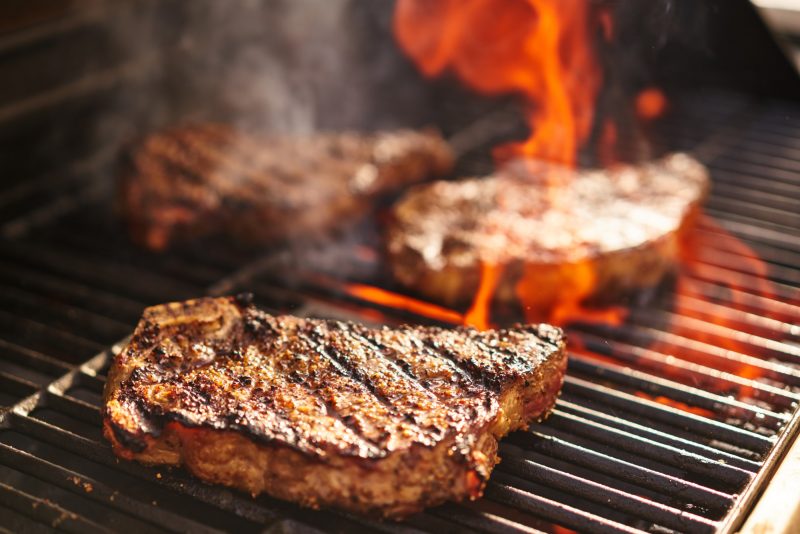Whether it be grilled, broiled, country fried, sous vide, or even tartare, beef has been a staple on American dinner plates for generations. And it doesn’t look like it’s going anywhere anytime soon.
In 2020 alone, about $30.3 billion in beef was sold nationwide. And different types of steak were king among those sales.
But what separates the varied types of steak? To answer that, let’s take a look at some common — and less common — cuts, and what makes each of them a unique dining experience.
The Main Cuts
Go out for a steak any night of the week, and you can expect to see some familiar names every time.
These are your basic cuts. You should reliably be able to find all of these at the meat counter of your local grocer. And by and large, they can all be counted on for a satisfying dining experience.
Top Sirloin
You could call top sirloin your “bread and butter” steak. This old standby is the most versatile cut of all types of steak, making it a good idea to always keep a couple on hand.
They pan-sear well, making them optimal for a quick and easy dinner after a long workday. However, one note to make is that because they’re so lean, they lack a lot of the flavor of their better-marbled counterparts.
To remedy the flavor situation, a basic marinade is the easiest option. Alternatively, sirloin dice nicely and make for a great foundation to a stir-fry.
Ribeye
After sirloin, ribeye is probably the next most popular cut. They’re much more marbled than sirloin, so while they can still be seared, they benefit much more from grilling.
In respect to seasoning, less-is-more when it comes to ribeye. The marbling already packs all the flavor you could ask for. A pinch of salt and pepper, maybe a little dry rub, that’s all you need.
One caveat to take note of is this cut’s tendency to cook very quickly. Rather than rely on a timed cook, it’s a good idea to use a meat thermometer to make sure you don’t overcook.
New York Strip
New York Strip is another popular choice.
Its fatty content makes it comparable to ribeye in many ways, to the extent that some laypersons view the differences as infinitesimal.
However, that’s not quite the case, and it’s worth looking up more info to understand what sets these two cuts apart.
On similarity it definitely does share with ribeye, however, is the ease of preparation. Just a dash of salt and pepper, grill on each side for 3-4 minutes, and you’ll reliably come away with a steakhouse perfect plate.
Filet Mignon
If you were to ask the average diner what the best type of steak is, they’d instinctively come back with “filet mignon.” And fair enough, this cut does have a lot to recommend it.
Being sourced from the tenderloin, a long muscle along the spine that doesn’t bear much weight, it’s bar-none the most tender cut. When well-prepared, it has an almost buttery quality that makes it melt in your mouth.
That is the sticking point, though: “well prepared.” Filet mignon is a very lean cut. And that lack of fat makes it susceptible to drying out if overcooked.
That’s why many chefs will sear them over high heat to create a nice seal, then finish them over low heat to prevent overcooking.
Some Different Types of Steak
The preceding cuts were the classics. They’re easy to find at any major grocer, and when cooked right, they’re always reliable.
The following are some more unique cuts that are nevertheless worth your attention. If the basic ribeye has grown wearisome, consider giving one of these types of steak cuts a try.
Flat Iron Steak
A recent advent, the flat iron steak, has quickly become a favorite among chefs and steak aficionados alike.
It’s one of the most tender cuts of steak, a close second after filet mignon. But being sourced from the beef shoulder, it is far better marbled than almost any other cut.
In terms of preparation, it’s another versatile cut, lending itself well to grilling, broiling, pan-frying, among other methods. Whatever your technique of choice, the flat iron’s marriage of tenderness and dense flavor are sure to make it one of your favorites.
Denver Steak
Like the flat iron, the Denver is another cut that’s only been around for about a decade. All the same, it’s become very popular in that short span of time.
It’s sourced from the eye of chuck, along the front shoulder. Normally this region would be too tough to be used as steak and instead finds use as stew meat or ground beef.
Denver steak, however, is culled from a part of the muscle that isn’t exercised as much as the rest of the shoulder. This produces a tender cut that nevertheless has plenty of marbling and flavor.
It’s best prepared over a very hot grill and then cut across the grain to keep it nice and tender.
Skirt Steak
Skirt steak is sourced from the plate beneath the ribs. This region makes it a fatty cut and an ideal candidate for the grill. Cook it fast and hot, and all of that marbling will melt into a slab of velvety goodness.
Or, if you’re craving some southwestern spice, the skirt steak is the classical choice for making steak fajitas. Marinade them for about 4-10 hours to soak up the spice blend, and they’ll sear up nicely with some sliced onions and peppers.
Selecting the Right Cut for Your Plate
It would be inaccurate to say any of the different types of steak is always the best choice. A filet mignon might be the most premium cut, but its lack of fat makes it ill-suited for certain dishes, for example.
Commit to memory the strengths of each cut, and you’ll make the right choice every time.
And remember that while the steak might be the centerpiece of the meal, it’s only one aspect. For all the tips you need to select the right accompaniment for each dish, be sure to keep up with all of our finest dining views.









